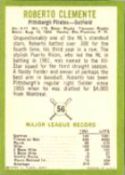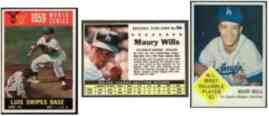Below are short bits & pieces on sportscard & baseball trading card collecting.
Please wander around the website for more info, prices, values & images
on vintage baseball, football, basketball, hockey, sport and non-sports cards.

1934,1935,1936 Diamond Matchbooks
During much of the Great Depression, matchbook collecting swept the country !
Sports matchbooks started appearing in the 1930s, most issued by Diamond Match Company
of New York. Over the next few years, several series were issued with
similar designs; b/w photo of the player on front with short write-up
and stats on back. The player's name and team was also printed on the 'saddle'.
Please consider the following info as approximate.
1934's first baseball release featured 200 players, in 4 different background
colors (red,blue,green and orange) for a total of 800 different covers.
The set features plenty of Hall-of-Fame greats like Dizzy Dean and Mel Ott.
1935's issue was tiny with only 24 total covers (8 red,8 blue,8 green).
A third series was later released with 200 or more different covers (players/colors).
1930's matchbook covers appear to be huge bargains for collectors as their current values
are fractions of the value of Goudey and other baseball cards from the same era.
Click for complete
1935-1936 Diamond Matchbook Checklist and Prices
Note: You may be on that page right now.
|



1963 Fleer Baseball Cards
Checklist & Values
1960 & 1961 Fleer baseball card sets of old-timers
like Babe Ruth bombed. Kids wanted Willie Mays & Mickey Mantle.
Topps had rights to baseball cards & gum so Fleer
tried something new ... COOKIES !!!
Cherry flavored cookies with 1963 baseball cards.

1963 Fleer baseball card set was cut short at 66 cards & checklist
by Topps lawsuit. But what 66 cards! Attractive & packed:
Clemente,Koufax... & 2 very scare Short Prints.

Maury Wills 'rookie' card is a story.
Majors in 1959, quickly superstar. But 1963 for rookie ???
In 1959 Topps deemed Wills NOT WORTHY.

 Wills was upset. After 1962 MVP, Topps came knocking but he said "NO!".
Finally, 1967, Wills first Topps & most costly card.
Note: 1961 Post Cereal card, years BEFORE
Wills was upset. After 1962 MVP, Topps came knocking but he said "NO!".
Finally, 1967, Wills first Topps & most costly card.
Note: 1961 Post Cereal card, years BEFORE
 'official' rookie. He also photo-bombed a 1960 Topps card.
'official' rookie. He also photo-bombed a 1960 Topps card.
Disclaimer: Above mostly true - but Wills has said "no feud".
Note: You may be on that page right now.
|

1954 Bowman Baseball
Cards Checklist & Values
Competition was raging between Topps and Bowman in 1953 and 1954 leading to
problems with both companies sets. Bowman caused Topps to missing 6 cards
in 1953 with Topps getting revenge by signing Ted Williams to an exclusive
contract in 1954. Bowman then had to pull Ted Williams card #66 from their
set shortly after they started printing, replacing it with Jimmy Piersall,
who also was on card #210 making the 1954 Bowman Ted Williams #6
one of 50's scarcest cards.
 Perhaps distracted by it's competition with Topps, the 1954 Bowman set was
filled with errors and variations. Nearly 20% (40/224 cards) had some sort
of variation, with some having more than 2.
Perhaps distracted by it's competition with Topps, the 1954 Bowman set was
filled with errors and variations. Nearly 20% (40/224 cards) had some sort
of variation, with some having more than 2.
The St. Louis Browns recent move to Baltimore also made things interesting.
Bowman's artists had no idea what an Orioles jersey would look like -
so they just madeone up.
 TOP ROOKIES: Don Larsen, Harvey Kuenn, Frank Thomas
TOP ROOKIES: Don Larsen, Harvey Kuenn, Frank Thomas
TOP STARS: Mickey Mantle, Willie Mays, Yogi Berra, Duke Snider,
Roy Campanella, Whitey Ford, Phil Rizzuto ...
Ted Williams is not considered part of a complete set.
Click for complete
1954 Bowman Baseball card checklist, values and prices.
Note: You may be on that page right now.
|

Baseball card collecting terms (part C)
Cabinet Card Were oversized trading cards featuring paintings issued
mostly 1910-1915.
Card Show is a gathering of dealers & collectors looking to buy/sell/trade
sports cards and memorabilia.
Card Stock is the material a card is printed on.
Usually paper-based, today companies play with the card stock and sometimes
it appears to be wood or leather or see-thru acrylic ...
Cello Pack is a card pack whose wrapper is see-thru plastic.
Usually the top & bottom cards are seen. Unopened cello packs showing
major stars and rookies sell for heavy premiums.
Centering is the balance of the borders: top/bottom & left/right.
On perfectly-centered cards, top/bottom borders match as do the
left/right borders.
Centering is presented as a set of numbers & directions and often included
with the grade. Perfectly-centered is "50/50 t/b" AND "50/50 l/r".
As centering gets worse, one number increases and the other decreases.
For example: 90/10 t/b is considered extremely off-center top to bottom.
The numbers add up to 100 (50/50, 60/40, 90/10 ...).
Certificate Of Authenticity (COA) A document used to verify legitimacy
of a collectible. NOTE: Keep in mind that COA's are easier to fake then autographs.
Common A card of a non-star player is considered a "Common" as
opposed to cards of a star players or specialty/subset cards such as
league leaders, teams cards, World Series cards...
Condition (Grade) Centering, corner wear, photo clarity, edges,
creases, print flaws ... all combine to determine a card's condition or grade.
Along with rarity/scarcity it is the major factor in a card's value.
Crease Defect usually caused by bending the card.
Hard to see, or not, a crease lowers the card's grade (VG or lower) and
greatly diminishes it's value.
© 1995-2019 "InterNet's Baseball Card Store" / Joseph Juhasz ... All Rights Reserved
|








